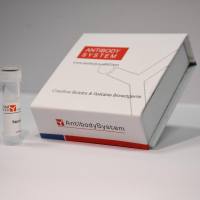In Vivo Assessment of Mouse Hindlimb Muscle Force, Contractile, and Fatigue Characteristics, and Motor Unit Number
互联网
- Abstract
- Table of Contents
- Materials
- Figures
- Literature Cited
Abstract
The use of rodents to model neuromuscular diseases necessitates assessment of neuromuscular function to monitor disease progression. Muscle function can be assessed by determining muscle force, and the contraction's contractile and fatigue characteristics. Assessment of motor units gives a measure of motoneuron health. Thus, assessment of these parameters can reveal the degree and nature of neuromuscular pathology. A reduction in muscle force may result either from loss of motoneurons and a concomitant denervation of muscles or as a result of primary muscle pathology. Estimation of the number of functional motor units may identify whether the deficit is neural in origin. Here, we give a detailed description of the assessment of muscle force, contractile characteristics, and muscle fatigue, as well as a method that gives a direct and accurate readout on the number of motor units in individual mouse hindlimb muscles in mice?now widely used to model a variety of neuromuscular disorders. Curr. Protoc. Mouse Biol. 2:89?101 © 2012 by John Wiley & Sons, Inc.
Keywords: muscle force; muscle fatigue; muscle contraction; motor unit; motoneuron; twitch force
Table of Contents
- Introduction
- Basic Protocol 1: Surgical Preparation of Mouse Hindlimb Muscles for Physiological Recordings
- Basic Protocol 2: Physiological Recording of Single‐Twitch Contractions to Determine Single‐Twitch Force and Time Characteristics of Single‐Twitch Contractions in Mouse Muscles
- Basic Protocol 3: Physiological Recording of Motor Units in the EDL Muscle of the Mouse
- Commentary
- Literature Cited
- Figures
- Tables
Materials
Basic Protocol 1: Surgical Preparation of Mouse Hindlimb Muscles for Physiological Recordings
Materials
Basic Protocol 2: Physiological Recording of Single‐Twitch Contractions to Determine Single‐Twitch Force and Time Characteristics of Single‐Twitch Contractions in Mouse Muscles
Materials
|
Figures
-

Figure 1. A graphic illustration on the position of muscles investigated in this protocol. The tibialis anterior (TA) and extensor digitorum longus (EDL) muscles are located anterior from the tibia, whereas the soleus muscle is located posterior from the bone; therefore, the dissection of this muscle is more practical from the prone position. View Image -

Figure 2. Analysis of single‐twitch traces obtained during isometric tension recordings. The figure shows two single‐twitch recordings obtained from the tibialis anterior (TA) muscles of a normal mouse (red represents the left side and blue represents right side). Using single‐twitch recordings like these, the following parameters can be read: twitch force ( g ) can be read by measuring the peak of the twitch trace; time to peak (TTP, milliseconds) is the time from the start of contraction until the peak of contraction; half relaxation time (HRT, milliseconds) is the time between the peak force and half value of the peak force on the relaxation phase. View Image -

Figure 3. Analysis of tetanic tension traces obtained during isometric tension recordings. The figure shows two tetanic tension traces obtained from the tibialis anterior (TA) muscles of a normal mouse (red represents the left side and blue represents right side). Single‐twitch recordings are also shown on the same graph. In order to achieve maximum force production the tetanic contractions were elicited by increasing stimulation frequencies; 40, 80, and 100 Hz. From recordings like these, the maximum force production can be measured in response to tetanic stimuli. Tetanic force ( g ) can be read by measuring the peak of the tetanus trace. View Image -

Figure 4. A characteristic fatigue trace obtained from a normal EDL muscle. The muscle was stimulated for 3 min through the sciatic nerve using 250‐msec tetanic pulses at 40‐Hz frequency. Muscle contractions were recorded using a chart recorder. For the analysis of the fatigue recording, the maximal and the minimal contraction trace were measured at the beginning and at the end of the recording period in mm (representing Ft0 and Ft180 as depicted in the graph). The fatigue index (FI) is a ratio between Ft180 and Ft0 . FI=Ft180 /Ft0 . View Image -

Figure 5. A typical motor unit's recording to assess functional motor units in normal EDL muscle in mouse is shown. Each trace represents a single‐twitch recording in response to sciatic nerve stimulation. By gradually increasing the stimulating voltage from 0 to 10 V, more motor units are recruited, which contribute incrementally to the amplitude of the recording trace. The number of motor units that innervate the EDL muscle can be calculated by counting the total number of increments (only traces that can be reproduced can be included into the counts). Because of this recording a total of 32 motor units were counted, which are shown as red‐dotted lines. View Image
Videos
Literature Cited
| Literature Cited | |
| Attal, P., Lambert, F., Marchand‐Adam, S., Bobin, S., Pourny, J.C., Chemla, D., Lecarpentier, Y., and Coirault, C. 2000. Severe mechanical dysfunction in pharyngeal muscle from adult mdx mice. Am. J. Respir. Crit. Care Med. 162:278‐281. | |
| Bacou, F. and Vigneron, P. 1988. Properties of skeletal muscle fibers. Influence of motor innervation. Reprod. Nutr. Dev. 28:1387‐1453. | |
| Bagust, J., Knott, S., Lewis, D.M. Luck, J.C., and Westerman, R.A. 1973. Isometric contractions of motor units in a fast twitch muscle of the cat. J. Physiol. 231:87‐104. | |
| Betz, W.J., Caldwell, J.H., and Ribchester, R.R. 1979. The size of motor units during post‐natal development of rat lumbrical muscle. J. Physiol. 297:463‐478. | |
| Brown, W.F. 1972. A method for estimating the number of motor units in thenar muscles and the changes in motor unit count with ageing. J. Neurol. Neurosurg. Psychiatry 35:845‐852. | |
| Burke, R.E., Levine, D.N., Tsairis, P., and Zajac, F.E. 3rd. 1973. Physiological types and histochemical profiles in motor units of the cat gastrocnemius. J. Physiol. 234:723‐748. | |
| Burke, R.E., Levine, D.N., Salcman, M., and Tsairis, P. 1974. Motor units in cat soleus muscle: Physiological, histochemical and morphological characteristics. J. Physiol. 238:503‐514. | |
| Kalmar, B., Novoselov, S., Gray, A., Cheetham, M.E., Margulis, B., and Greensmith, L. 2008. Late stage treatment with arimoclomol delays disease progression and prevents protein aggregation in the SOD1 mouse model of ALS. J. Neurochem. 107:339‐350. | |
| Litvinova, K.S., Tarakin, P.P., Fokina, N.M., Istomina, V.E., Larina, I.M., and Shenkman, B.S. 2007. Reloading of rat soleus after hindlimb unloading and serum insulin‐like growth factor 1. Ross. Fiziol. Zh. Im. I. M. Sechenova 93:1143‐1155. | |
| Louboutin, J.P., Fichter‐Gagnepain, V., Pastoret, C., Thaon, E., Noireaud, J., Sebille, A., and Fardeau, M. 1995. Morphological and functional study of extensor digitorum longus muscle regeneration after iterative crush lesions in mdx mouse. Neuromuscul. Disord. 5:489‐500. | |
| Lowrie, M.B. and Vrbova, G. 1984. Different pattern of recovery of fast and slow muscles following nerve injury in the rat. J. Physiol. 349:397‐410. | |
| McComas, A.J. 1991. Invited review: Motor unit estimation: Methods, results, and present status. Muscle Nerve 14:585‐597. | |
| McComas, A.J., Fawcett, P.R., Campbell, M.J., and Sica, R.E. 1971. Electrophysiological estimation of the number of motor units within a human muscle. J. Neurol. Neurosurg. Psychiatry 34:121‐131. | |
| Pastoret, C. and Sebille, A. 1993. Time course study of the isometric contractile properties of mdx mouse striated muscles. J. Muscle Res. Cell Motil. 14:423‐431. | |
| Rafuse, V.F., Pattullo, M.C., and Gordon, T. 1997. Innervation ratio and motor unit force in large muscles: A study of chronically stimulated cat medial gastrocnemius. J. Physiol. 499:809‐823. | |
| Salmons, S. and Vrbova, G. 1969. The influence of activity on some contractile characteristics of mammalian fast and slow muscles. J. Physiol. 201:535‐549. | |
| Sharp, P.S., Dick, J.R., and Greensmith, L. 2005. The effect of peripheral nerve injury on disease progression in the SOD1(G93A) mouse model of amyotrophic lateral sclerosis. Neuroscience 130:897‐910. | |
| Spurney, C.F., Gordish‐Dressman, H., Guerron, A.D., Sali, A., Pandey, G.S., Rawat, R., Van Der Meulen, J.H., Cha, H.J., Pistilli, E.E., Partridge, T.A., Hoffman, E.P., and Nagaraju, K. 2009. Preclinical drug trials in the mdx mouse: assessment of reliable and sensitive outcome measures. Muscle Nerve 39:591‐602. |









